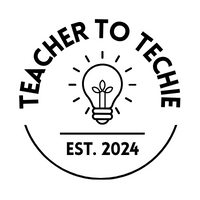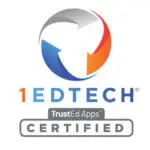Introduction to Teaching with AI
Teaching with AI holds tremendous promise. Never have we seen a technology redefining the classroom and the teacher’s role in it in such a short time span. Teaching with AI is no longer a goal for the future; the future is here now. So how do teachers learn to incorporate AI into their classrooms? By consulting with experts, of course!
We had the good fortune of interviewing one such expert– Lauren Farrow, founder of Teacher To Techie, to get practical tips for bringing AI into different classroom settings. From flipped classrooms to project-based learning and beyond, Lauren has provided us a myriad of ways to be teaching with AI.
A Passion Turns Into a Company
 What started as a passion for one teacher in Orange County, FL has turned into a promising company. Lauren Farrow was in the classroom when ChatGPT 3.5 went live. As she dove in, fascinated and excited by the potential, she encouraged her colleagues to do so, too. Experimenting in her classroom by refining her lesson plans and redesigning the learning activities, she soon was teaching with AI and became the AI guru at her school.
What started as a passion for one teacher in Orange County, FL has turned into a promising company. Lauren Farrow was in the classroom when ChatGPT 3.5 went live. As she dove in, fascinated and excited by the potential, she encouraged her colleagues to do so, too. Experimenting in her classroom by refining her lesson plans and redesigning the learning activities, she soon was teaching with AI and became the AI guru at her school.
Lauren started a marketing business on the side now that LLMs could help her do the work of three people. What teacher doesn’t need a side hustle these days? Yet she was constantly working on incorporating AI into her own teaching and mentoring her colleagues. Soon she realized that she had to share her passion, knowledge, and skills by offering AI training to educators based on her first-hand experiences.
 Ms. Farrow left the classroom in May of 2024 and is now an edupreneur. Her nascent company Teacher to Techie provides professional development to educators and institutions on how to successfully use AI in their classrooms.
Ms. Farrow left the classroom in May of 2024 and is now an edupreneur. Her nascent company Teacher to Techie provides professional development to educators and institutions on how to successfully use AI in their classrooms.
Interview with Lauren Farrow, Founder of Teacher To Techie
**Interviewer**: Integrating AI into education isn’t a one-size-fits-all approach. Each classroom setting offers unique opportunities and challenges. How can AI solutions be tailored to address these variations effectively?
**Lauren Farrow**: You’re absolutely right. Each classroom environment is unique, and AI needs to be adapted to meet those specific needs. At Teacher To Techie, we’ve developed data-backed strategies for incorporating AI into 12 distinct classroom settings. Our goal is to enhance teaching with AI, streamline administrative tasks, and create a more dynamic learning experience for students. Let’s dive into how AI can be effectively utilized in these different classroom settings.
Flipped Classroom
**Interviewer**: That sounds great. Let’s start with the flipped classroom. How can teaching with AI be leveraged here?
**Lauren Farrow**: In a flipped classroom, AI can significantly enhance content delivery and engagement. We use AI-driven platforms like adaptive learning software to personalize the content students access at home. For example, tools like Edpuzzle can integrate quizzes into videos to assess understanding in real-time, while chatbots provide instant answers to student questions, making the home learning experience more interactive and supportive. When students return to the classroom, they can show what they know by completing interactive quizzes on a platform like TeacherMade. (It can be set to prevent copying and pasting so teachers can be sure the students’ work is their own.)
Blended Learning
**Interviewer**: How about blended learning? How can we be teaching with AI in this environment?
**Lauren Farrow**: Blended learning benefits greatly from AI by harmonizing online and offline learning experiences. Implementing AI-driven learning management systems (LMS) can track student progress and adapt lessons accordingly. Tools like DreamBox or Knewton personalize learning pathways and offer insights to help teachers adjust in-class activities based on online performance, ensuring a seamless learning experience across both environments. In-class activities generated by these apps or chatbots can be delivered to students in TeacherMade’s interactive platform, complementing both online and offline lessons.
Project-Based Learning (PBL)
**Interviewer**: Project-Based Learning (PBL) is quite popular. How can teaching with AI enhance this setting?
**Lauren Farrow**: For Project-Based Learning, AI tools can be game-changers in planning and execution. AI-enhanced project management tools like Trello help students manage timelines and tasks more effectively. Additionally, AI-driven research assistants such as Elicit can assist in gathering and organizing research data, making the entire project process more efficient and thorough.
Inquiry-Based Learning
**Interviewer**: Inquiry-Based Learning focuses on student-driven questioning. How does teaching with AI support this?
**Lauren Farrow**: Inquiry-Based Learning thrives on deep questions and thorough research. Integrating AI tools like Wolfram Alpha or IBM Watson can help students answer complex questions and conduct deeper research. AI-powered simulation tools also help students visualize and experiment with concepts, enhancing their understanding and engagement. To provide a starting point, teachers can link together URLS, media, simulations and more within TeacherMade, which is a perfect platform for students to document their research and reflections.
Personalized Learning
**Interviewer**: Personalized Learning is crucial for individual student success. How can teaching with AI facilitate this?
**Lauren Farrow**: AI is perfect for personalized learning because it can tailor educational experiences to individual needs. AI-driven platforms like iReady or Smart Sparrow adapt content to each student’s learning style and pace, providing personalized feedback and recommending specific resources for improvement. This ensures every student gets the support they need to succeed. AS Gemini gets integrated into Google Classroom, students’ needs can be addressed within AI-generated personalized content and delivered to students via Google Forms or Practice– or with TeacherMade if interactivity and instant feedback is desirable.
Cooperative Learning
**Interviewer**: What about Cooperative Learning? How can teaching with AI enhance collaboration?
**Lauren Farrow**: In cooperative learning settings, AI can streamline communication and project management. Tools like Slack with AI plugins can facilitate efficient communication and collaboration among students. AI-driven platforms such as Google Workspace (only for students 18 and older) offer smart suggestions and help in co-creating documents and presentations. This makes group work more cohesive and productive.
Gamification
**Interviewer**: Gamification is increasingly popular. How does AI play a role here?
**Lauren Farrow**: AI can take gamification to the next level by personalizing and enhancing the gamified experience. Platforms like Classcraft use AI to adjust challenges and rewards based on individual student performance and engagement levels. AI can also analyze game data to provide insights into student learning and motivation, making gamified learning more effective. TeacherMade incorporates gamified feedback so students have the opportunity to keep refining their understanding.
Montessori Method
**Interviewer**: How can teaching with AI happen within the Montessori Method, which focuses on individualized and exploratory learning?
**Lauren Farrow**: In Montessori settings, AI-driven learning apps can provide personalized experiences and recommendations based on each child’s progress. Tools like Montessori Compass, with AI features, can track development and suggest appropriate activities, supporting the Montessori philosophy of self-directed, hands-on learning.
Waldorf Education
**Interviewer**: Waldorf Education emphasizes holistic and creative learning. Can AI be integrated here without overshadowing the creative aspects?
**Lauren Farrow**: AI can be subtly integrated into Waldorf education to support holistic learning while keeping the focus on creativity. AI can manage administrative tasks, freeing up more time for creative teaching with AI. Additionally, AI tools for digital storytelling or music composition can enhance arts education, ensuring that technology complements rather than overshadows the creative process.
Hybrid Learning
**Interviewer**: Hybrid learning combines online and offline education. How does AI play a role in these differing environments?
**Lauren Farrow**: AI helps balance hybrid learning by monitoring and analyzing student engagement and performance in both online and offline settings. AI platforms like Coursera or Khanmigo provide tailored content for online segments, while in-person sessions focus on interactive, AI-informed activities. This ensures a cohesive and comprehensive learning experience. TeacherMade’s platform can also seamlessly integrate into hybrid learning models by offering teacher-created interactivities that can be accessed both online and offline, ensuring consistency in learning experiences.
Experiential Learning
**Interviewer**: Experiential Learning involves real-world experiences. How can AI enhance this approach?
**Lauren Farrow**: AI can enhance experiential learning by organizing and reflecting on real-world experiences. Tools like Xello use AI capabilities to match students with relevant internships or service-learning opportunities based on their interests and career goals. AI can also help students document and reflect on their experiences, deepening their learning. TeacherMade can support experiential learning and teaching with AI by providing customizable templates for documenting and reflecting on real-world experiences. This makes it easier for students to connect their learning to practical applications.
Socratic Method
**Interviewer**: Lastly, how can teaching with AI enhance the Socratic Method, which relies on dialogue and critical thinking?
**Lauren Farrow**: Teaching with AI can enliven the Socratic Method by analyzing and enhancing classroom discussions. Tools like ChatGPT can generate thought-provoking questions and provide instant feedback on students’ responses, fostering deeper critical thinking and engagement. This allows teachers to facilitate richer and more meaningful conversations. TeacherMade can be used to create interactive question sets and worksheets that encourage critical thinking and dialogue, also supporting the Socratic method and teaching with AI.
**Interviewer**: Thank you, Lauren Farrow of Teacher to Techie. Your insights into how AI can be integrated into diverse classroom settings are incredibly valuable. It’s clear that teaching with AI has the potential to revolutionize education in so, so many ways. And we appreciate you sharing your expertise with our TeacherMade audience.
**Lauren Farrow**: Thank you! It’s been a pleasure sharing how AI can enhance our teaching practices. The future of education with AI is bright, and I’m excited to see how these tools will continue to evolve and support educators and students alike.
Key Points for Teaching with AI
Now that we’ve explored the different ways teaching with AI can enhance various classroom settings, let’s break it down into some actionable steps. Here are the key implementation points to get you started. Trust me, these tips will make integrating AI into your teaching practice a breeze!
Teaching With AI Recommendations
- Assess Needs: Understand the unique needs and goals of your classroom setting before selecting AI tools.
- Start Small: Begin with one or two AI applications to ease the transition and build confidence.
- Provide Training: Ensure teachers and students are adequately trained to use AI tools effectively.
- Monitor and Adapt: Continuously monitor the effectiveness of AI implementations and be ready to adapt strategies as needed.
- Ongoing Change Management: Cultivate a positive attitude towards AI by highlighting its benefits and providing ongoing support.
- Use TeacherMade to Deliver Your AI-Generated Content: Chatbots can produce educational content and activities in a flash. TeacherMade should be used to deliver the content to your students in an interactive format; it’s more engaging than a Google Form or a document. And with the added bonus of AI grading, teachers will have more time to harness AI for learning.
By carefully integrating AI into these various classroom settings, we can enhance learning experiences, streamline administrative tasks, and ultimately create a more engaging and effective educational environment.
Teaching with AI Challenges and Considerations
Let’s be real—while AI has the potential to revolutionize education, it’s not without its challenges. Many teachers and parents have concerns, and it’s important to address these head-on.
One common concern is privacy. There’s a lot of worry about student data being collected and potentially misused, which is a valid concern we need to take seriously. Another major fear is job displacement. Some worry that AI might replace teachers, but it’s important to remember that AI should be used to assist teachers, not replace us. Additionally, the sheer amount of new tools can feel overwhelming, leading to a sense of tech overload.
To overcome these challenges, staying informed about the latest in AI ethics and privacy standards is crucial. Make sure any AI tools you use comply with regulations and prioritize student data protection. Regular professional development can also ease fears about job displacement by showing teachers how AI can enhance their role in the classroom, not replace them.
Starting small by introducing AI tools gradually can help manage the sense of tech overload. Though recent surveys show as many as 50% of teachers use AI tools weekly, there are at least 50% who don’t. Begin with one or two applications that have clear benefits and are easy to integrate into existing workflows. Lastly, engaging the broader school community, especially parents, in discussions about teaching with AI can help build trust and transparency.
Remember, the goal is to use AI to make the teacher’s job easier and enhance student learning, not to add stress or create new problems. Use familiar tools to deliver AI-generated content in the classroom, like Google Forms or TeacherMade. TeacherMade’s user-friendly interface and comprehensive support resources make it an ideal starting point for teachers new to integrating AI tools into their classrooms, helping to alleviate the sense of tech overload.
Conclusion
Whether you’re using a flipped classroom, project-based learning, or personalized learning, there’s an AI tool out there that can help. Starting small, staying informed, and engaging your community are key steps to ensure a smooth transition. Then as AI technology continues to evolve, our learning communities will be receptive to even more innovative tools that will redefine teaching and learning. Imagine a classroom where AI helps identify each student’s unique needs and tailors instruction accordingly—it’s closer than you think!
Now it’s your turn. Explore some AI tools and think about how they could fit into your teaching practice. Try out a new app, attend a workshop, or simply start a conversation with your colleagues about AI. And remember, no matter where you get your AI content, when it’s time to deliver it to your students, choose TeacherMade for the most interactive and stress-free experience. Happy teaching!






